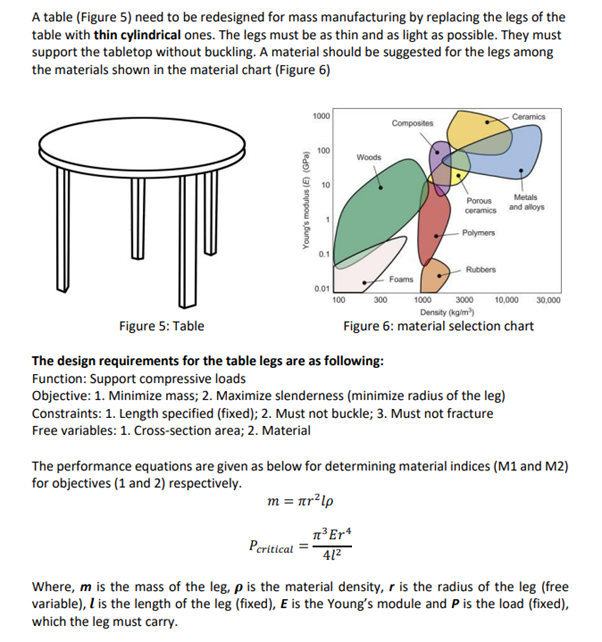A table (Figure 5) need to be redesigned for mass manufacturing by replacing the legs of the table with thin cylindrical ones. The legs must be as thin and as light as possible. They must support the tabletop without buckling. A material should be suggested for the legs among the materials shown in the material chart (Figure 6) Young's modulus (E) (GPa) 1000 100 0.01 100 Woods 300 Composites ³ Er 41² Foams Porous ceramics Polymers Rubbers 1000 Density (kg/m³) Figure 6: material selection chart Ceramics Figure 5: Table The design requirements for the table legs are as following: Function: Support compressive loads Objective: 1. Minimize mass; 2. Maximize slenderness (minimize radius of the leg) Constraints: 1. Length specified (fixed); 2. Must not buckle; 3. Must not fracture Free variables: 1. Cross-section area; 2. Material Metals and alloys 3000 10,000 30,000 The performance equations are given as below for determining material indices (M1 and M2) for objectives (1 and 2) respectively. m = nr²lp Peritical Where, m is the mass of the leg, p is the material density, r is the radius of the leg (free variable), I is the length of the leg (fixed), E is the Young's module and P is the load (fixed), which the leg must carry.
A table (Figure 5) need to be redesigned for mass manufacturing by replacing the legs of the table with thin cylindrical ones. The legs must be as thin and as light as possible. They must support the tabletop without buckling. A material should be suggested for the legs among the materials shown in the material chart (Figure 6) Young's modulus (E) (GPa) 1000 100 0.01 100 Woods 300 Composites ³ Er 41² Foams Porous ceramics Polymers Rubbers 1000 Density (kg/m³) Figure 6: material selection chart Ceramics Figure 5: Table The design requirements for the table legs are as following: Function: Support compressive loads Objective: 1. Minimize mass; 2. Maximize slenderness (minimize radius of the leg) Constraints: 1. Length specified (fixed); 2. Must not buckle; 3. Must not fracture Free variables: 1. Cross-section area; 2. Material Metals and alloys 3000 10,000 30,000 The performance equations are given as below for determining material indices (M1 and M2) for objectives (1 and 2) respectively. m = nr²lp Peritical Where, m is the mass of the leg, p is the material density, r is the radius of the leg (free variable), I is the length of the leg (fixed), E is the Young's module and P is the load (fixed), which the leg must carry.
Elements Of Electromagnetics
7th Edition
ISBN:9780190698614
Author:Sadiku, Matthew N. O.
Publisher:Sadiku, Matthew N. O.
ChapterMA: Math Assessment
Section: Chapter Questions
Problem 1.1MA
Related questions
Question
i want an abstract detailed selection and process for the type of leg to be used for this use case please

Transcribed Image Text:A table (Figure 5) need to be redesigned for mass manufacturing by replacing the legs of the
table with thin cylindrical ones. The legs must be as thin and as light as possible. They must
support the tabletop without buckling. A material should be suggested for the legs among
the materials shown in the material chart (Figure 6)
Young's modulus (E) (GPa)
1000
100
0.1
Peritical =
0.01
100
m = πr²lp
Woods
Composites
300
π³ Er4
41²
Foams
Porous
ceramics
Polymers
Rubbers
1000
3000
Density (kg/m³)
Figure 6: material selection chart
Figure 5: Table
The design requirements for the table legs are as following:
Function: Support compressive loads
Objective: 1. Minimize mass; 2. Maximize slenderness (minimize radius of the leg)
Constraints: 1. Length specified (fixed); 2. Must not buckle; 3. Must not fracture
Free variables: 1. Cross-section area; 2. Material
Ceramics
Metals
and alloys
The performance equations are given as below for determining material indices (M1 and M2)
for objectives (1 and 2) respectively.
10,000 30,000
Where, m is the mass of the leg, p is the material density, r is the radius of the leg (free
variable), I is the length of the leg (fixed), E is the Young's module and P is the load (fixed),
which the leg must carry.
Expert Solution
This question has been solved!
Explore an expertly crafted, step-by-step solution for a thorough understanding of key concepts.
Step by step
Solved in 3 steps with 2 images

Knowledge Booster
Learn more about
Need a deep-dive on the concept behind this application? Look no further. Learn more about this topic, mechanical-engineering and related others by exploring similar questions and additional content below.Recommended textbooks for you

Elements Of Electromagnetics
Mechanical Engineering
ISBN:
9780190698614
Author:
Sadiku, Matthew N. O.
Publisher:
Oxford University Press

Mechanics of Materials (10th Edition)
Mechanical Engineering
ISBN:
9780134319650
Author:
Russell C. Hibbeler
Publisher:
PEARSON

Thermodynamics: An Engineering Approach
Mechanical Engineering
ISBN:
9781259822674
Author:
Yunus A. Cengel Dr., Michael A. Boles
Publisher:
McGraw-Hill Education

Elements Of Electromagnetics
Mechanical Engineering
ISBN:
9780190698614
Author:
Sadiku, Matthew N. O.
Publisher:
Oxford University Press

Mechanics of Materials (10th Edition)
Mechanical Engineering
ISBN:
9780134319650
Author:
Russell C. Hibbeler
Publisher:
PEARSON

Thermodynamics: An Engineering Approach
Mechanical Engineering
ISBN:
9781259822674
Author:
Yunus A. Cengel Dr., Michael A. Boles
Publisher:
McGraw-Hill Education

Control Systems Engineering
Mechanical Engineering
ISBN:
9781118170519
Author:
Norman S. Nise
Publisher:
WILEY

Mechanics of Materials (MindTap Course List)
Mechanical Engineering
ISBN:
9781337093347
Author:
Barry J. Goodno, James M. Gere
Publisher:
Cengage Learning

Engineering Mechanics: Statics
Mechanical Engineering
ISBN:
9781118807330
Author:
James L. Meriam, L. G. Kraige, J. N. Bolton
Publisher:
WILEY